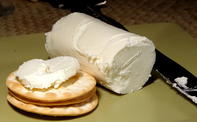Goat milk is very nutritious, has a protein composition similar to human breast milk and is more digestible than cow milk. In cow milk, casein is the main constituent of the protein content, but in goat milk its concentration is much lower.

This compound can cause indigestion in humans due to the formation of solid curds in the stomach. Goat milk contains smaller fat globules and more short and medium chain fatty acids than cow milk.
This improves the digestibility of goat milk. In addition, goat milk contains vitamins A, E, B1 (50 % more than cow milk), B2, and C as well as minerals such as potassium, calcium, magnesium, phosphorus, iron, copper, and zinc.
Breeding Cycle of Milk Goats
If goats are managed properly, the first kidding (birth of the first baby goat) can take place within 12 months. Half the goats will have twins at first kidding and all will have twins at subsequent kidding.
Lactation (milk production) after kidding usually lasts for about ten months. If it lasts longer, goats will have to be dried off deliberately. In the summer rainfall areas kids born in early summer usually do better than those born later.
It is a good idea to spread out the breeding season to ensure continuity of milk production. Plan kidding (peak milk production) to be spread out over several months to ensure that surplus milk will not be a problem.
Goat Milk Market
The world’s leading exporting country of goat milk cheese is Germany, yet the world’s leading producer of goat milk is India. The world’s leading importer of goat cheese is Italy. Goat’s milk can be marketed as fresh, frozen or dried (powdered) milk.
It can be sold to individual customers or manufacturers. Goats milk can be made into kefir (a fermented milk drink), cheese, yoghurt, fudge, ice cream and condensed milk. Goat’s milk sold fresh or frozen should be in sealed containers (usually plastic or glass bottles or sachets). Goat’s milk freezes well, its quality is not affected by freezing.
Fresh milk sold directly to customers will get a better price than selling it to cheese manufacturers. Cheese can be made either from pure goat’s milk or goat’s milk blended with other kinds of milk. The final product should be attractively packaged, of consistent quality, readily available and well-priced.
Goat milk products made in India include chhana (a soft unripened cheese curd), khoa (similar to ricotta cheese), and paneer (a non-melting cheese.) Cajeta in Mexico and gjetost in Norway are popular caramelized sweet products made from goat milk. Goat milk contains lactic acid which is a natural exfoliator and with the pH very similar to human skin, it is ideal for use in body products.
Cosmetic products made from goat milk is suitable for use on sensitive skin and skin problems such as eczema, psoriasis, rosacea, acne and shingles. Goat milk products (often combined with natural oils and beeswax) include goat milk soap, lip balms, bath salts, cleansers and body lotions, which are produced in many countries including South Africa.
By Marinda Louw